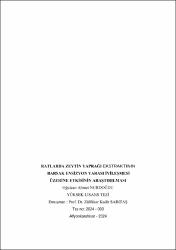Ratlarda zeytin yaprağı ekstraktının barsak ensizyon yarası iyileşmesi üzerine etkisinin araştırılması
Özet
Yapılan çalışmada, ratlarda barsak ensizyon yarasında zeytin yaprağı ekstraktının iyileşme üzerine etkilerinin araştırılması amaçlanmıştır.
Çalışma 32 adet erişkin yaşta Wistar Albino ırkı erkek Rat üzerinde gerçekleştirildi. Ratlar ilk gün aneztesi altında median laparotomiyi takiben kolon descende bölgesinde 2-3 cm boyutunda kesi yapılarak yara oluşturulduktan sonra cerrahi prosedürlere uygun olarak operasyon bölgesi kapatıldı. Kontrol, Sham, Grup 1 ve Grup 2 olmak üzere 4 gruba ayrıldı. Grup 1 grubuna 3.gün (n=4) ve 7.(gün) 200 mg/kg/gün, Grup 2 grubuna 3.gün (n=4) ve 7.gün (n=4) 400 mg/kg/gün uygulandıktan sonra ratlar sakrifiye edilerek histopatolojik, biyokimyasal ve hemotoloji yönünden değerlendirmeler yapıldı.
Histopatolojik değerlendirmeler sonucunda zeytin yaprağı uygulanan Grup 1 ve Grup 2 de yer alan inflamatuar hücre , fibroblastik, neovaskülarizasyon ve kollajen değerlerinin 3. gün ve 7. günlerinde yer alan sonuçları Kontrol ve Sham grubu ile karşılaştırıldığında istatiksel olarak anlamlı farklılıklar gözlemlendi (p<0.05). Biyokimyasal değerlendirmelerde ise HYP (p* 0,693) dışında olan diğer TAS (p* 0,010), TOS (p* 0,001), IL-1 (p*0,000), IL-6 (p*0,018), TNF-α (p*0,14) ve NO (p*0,001) değerlerinde istatiksel olarak değerlendirildiğinde anlamlı farklılıklar gözlenmiştir (p<0.05). Hemotoloji değerlerinden GRA, GRA(%) ve PLT değerlerinde istatiksel yönden anlam ifade eden farklar kayıt edilmiştir (p<0.05). Sonuç olarak; ratlarda barsak enzisyon yarası iyileşmesi üzerine 200 mg/kg/gün ve 400 mg/kg/gün dozlarında kullanılan 3 gün ve 7 gün süre ile gavaj yolu ile verilen zeytin yaprağı ekstraktının 7. gün iyileşmesi üzerine olumlu etkisinin daha olumlu olduğu yapılan histopatalojik, biyokimyasal ve hematolojik incelemeler ile ortaya konmuş olup ancak daha ayrıntılı araştırmalara ihtiyaç olduğu kanısındayız. The study realized that was aimed to investigate the effects of olive leaf extract on healing of intestinal incision wounds in rats. In the study was realized on 32 adult Wistar Albino male rats. The rats applied general anesthesia on the first daywith followed by median laparotomy, a 2-3 cm incision was made in the descendens colon region to create a wound. Subsequently, the surgical region was closed according to appropriate surgical procedures. Groups were divided into four group as a Control, Sham, Group 1 and, Group 2. After administering 200 mg/kg/day of olive leaf extract to Group 1 on the 3rd day (n=4) and 7th day (n=4), and 400 mg/kg/day of olive leaf extract to Group 2 on the 3rd day (n=4) and 7th day (n=4) via gastric gavage applied, after that rats were sacrificed and histopathological, biochemical, and hematological evaluations.
As a result of the histopathological evaluations, statistically significant differences (p<0.05) were observed in the inflammatory cell, fibroblastic, neovascularization, and collagen values in Group 1 and Group 2, which applied olive leaf treatment on the 3rd and 7th days, compared to the Control and Sham groups. In the biochemical evaluations, statistically significant differences were observed (p<0.05) in the TAS (p* 0.010), TOS (p* 0.001), IL-1 (p*0.000), IL-6 (p*0.018), TNF-α (p*0.14), and NO (p*0.001) values, except for HYP (p* 0.693). Statistically significant differences were observed in the hematology values of GRA, GRA(%), and PLT (p<0.05).
As a consequently; histopathological, biochemical and clinical findings showed that olive leaf extract given by gavage for 3 days and 7 days, at doses of 200 mg/kg/day and 400 mg/kg/day, had a more positive effect on intestinal incision wound healing in rats, on healing on the 7th day. It has been revealed by hematological examinations, but we believe that more detailed research is needed.
Bağlantı
https://hdl.handle.net/11630/11408Koleksiyonlar
- Yüksek Lisans Tezleri [667]



















